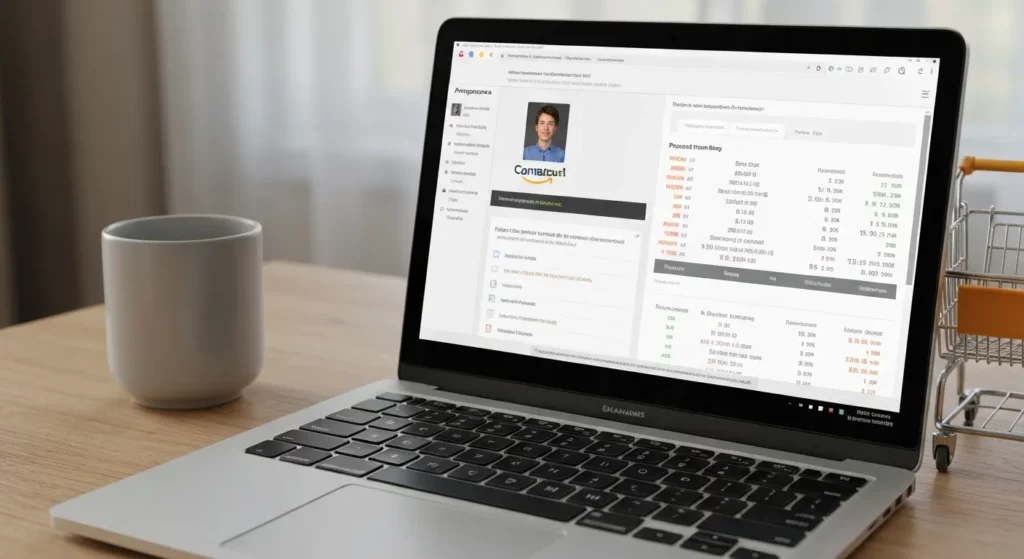My retirement started with a spreadsheet and a cup of lukewarm coffee. The numbers stared back at me, cold and unforgiving. After decades of working, of saving, of planning, this was it. The income was fixed, a reliable but finite stream. My spending, however, felt like a wild river I could no longer control. And the biggest, most tempting tributary flowing into that river had a smiling logo: Amazon.
I loved the convenience. Who doesn’t? In my first few months of retirement, a day didn’t go by without that familiar cardboard box landing on my porch. New gardening gloves, a specific brand of coffee my wife loves, a book I’d heard about on the radio. It was effortless. Too effortless. Each small, seemingly harmless purchase was a tiny leak in my carefully constructed financial boat.
The breaking point came over a bird feeder. Not just any bird feeder, mind you. This was a fancy one with a built-in camera that could identify the species and send photos to my phone. I’d seen it advertised, and as a newfound bird-watching enthusiast, I was completely captivated. It was the perfect retirement hobby accessory. I clicked on it, saw the price—$229.99—and my heart sank. It wasn’t an impossible amount, but it was an irresponsible one. It was the kind of purchase I’d have made without a second thought before, but now, on my new budget, it felt like a splurge I just couldn’t justify.
I closed the laptop with a sigh of frustration. I felt a mix of anger and disappointment. Was this what retirement was going to be? A constant state of wanting things and telling myself no? It felt limiting, and honestly, a little embarrassing. That night, I couldn’t sleep. The bird feeder wasn’t the real issue. It was a symbol of a larger problem: I felt like I had lost control of my spending, and this giant, faceless corporation was designed to make it worse.
Lying in the dark, I decided I wasn’t going to be a passive victim of the “Add to Cart” button. If Amazon was a system designed to get the most money out of me, then I was going to learn how that system worked. I was going to find its weaknesses. I wasn’t just going to save money; I was going to win the game. This became my mission, my new, slightly obsessive hobby. My goal was simple: I was going to figure out how to trick Amazon’s algorithm for lower prices.
My First Discovery: The Myth of a “Fixed Price”
My journey didn’t start with some complex software or secret knowledge. It started with a simple, nagging question. Late one night, scrolling through a finance forum for retirees, I saw a comment that caught my eye. Someone mentioned “dynamic pricing.” The idea was that online retailers, especially Amazon, show different prices to different people for the same exact item.
I was immediately skeptical. It sounded like a conspiracy theory. Surely that was illegal or, at the very least, deeply unethical. The price is the price, right? But the idea took root. The next morning, fueled by a fresh cup of coffee and a sense of purpose, I decided to run a little experiment.
The target was my bird feeder. I opened my browser, logged into my Amazon account as usual, and searched for it. There it was: $229.99. Prime shipping. The price stared back at me, just as daunting as before.
Then, I remembered the forum post suggesting that Amazon tracks your every move. It knows your purchase history, what you look at, how long you linger on a page. It knows I’m a Prime member who buys things frequently. Perhaps, I thought, it knows I’m a prime target for a higher price. It knows I value convenience.
So, I tried something simple. I opened a “Private” or “Incognito” browser window. This feature, which I’d only ever heard about, is supposed to stop websites from tracking you. It’s like putting on a digital disguise. In this new, anonymous window, I went to Amazon.com. The site didn’t greet me by name. It didn’t know me.
I typed in the name of the bird feeder and hit enter. My heart beat a little faster. And there it was. The same item, sold by the same seller, fulfilled by Amazon.
The price? $214.99.
I stared at the screen for a full minute. Fifteen dollars. It wasn’t a fortune, but it wasn’t nothing. It was proof. Proof that the price wasn’t fixed. Proof that I was being shown a higher price simply because of who I was—a loyal, logged-in Prime customer. The feeling wasn’t just happiness at the potential savings; it was a jolt of vindication. I wasn’t crazy. The game was real.
This became my first rule, the cornerstone of my new strategy. Never, ever search for an item while logged into my account. I do all my initial browsing in an incognito window. I treat it like window shopping in the real world. I’m just looking, not committing. I only log in at the very last moment when I’m ready to make the purchase, after I’ve locked in the lowest price I can find.
That small victory, that fifteen-dollar difference, was more thrilling than any impulse purchase I had ever made. It was the first clue in a mystery I was becoming determined to solve.
The Waiting Game: How I Turned My Cart into a Bargaining Chip
My initial discovery with the incognito window was empowering, but I knew it was just the tip of the iceberg. The algorithm was clearly more complex than just checking if I was logged in. My next big breakthrough came, like many great discoveries, completely by accident.
There was a set of high-quality kitchen knives my wife had been admiring. They were beautiful, German-made, and carried a price tag of nearly $300. Using my new incognito trick, I found them for $285. Better, but still too much for our budget. I wanted to keep an eye on them, so I logged in, added the knives to my shopping cart, and then just… left them there. Life got busy, a week went by, and I honestly forgot about them.
Then, an email from Amazon popped into my inbox. It wasn’t the usual “You have items in your cart!” reminder. The subject line was different. It read: “Did You See? A Price Dropped on an Item in Your Cart!”
I opened it with cautious optimism. The knives were now listed at $249.99. Another thirty-five dollars had vanished from the price, just by waiting.
That’s when the second piece of the puzzle clicked into place. The Amazon algorithm isn’t just a passive calculator; it’s an active negotiator. By placing an item in my cart and walking away, I had sent a powerful signal. I was saying, “I’m interested, but not at that price.” Amazon, in its automated, data-driven wisdom, decided it would rather make a sale at a lower margin than no sale at all. It had called my bluff, and when I didn’t flinch, it blinked first.
This led to the development of what I now call my “48-Hour Cart Rule.” It’s one of my most effective amazon hacks. For any non-urgent purchase over about $50, I follow a strict procedure:
- I find the item I want using an incognito window to see the baseline price.
- I log into my account, add the item to my cart, and then immediately close the browser tab.
- I wait. I resist the urge to check on it. I give it at least 48 hours.
It’s astonishing how often this works. It doesn’t happen every time, but I’d say a good 30-40% of the time, I get that magical price-drop email or a notification on the app. It’s a powerful lesson in patience. In a world built on instant gratification, simply waiting has become my superpower.
I started using my Wish List in the same way. The Wish List is an even more passive signal. It says “I like this, but I’m not even ready to think about buying it yet.” Amazon watches that too. I’ve added items to a “Future Purchases” wish list and received notifications weeks or even months later that the price had dropped significantly, often to an all-time low.
This strategy did more than just lower Amazon prices for me. It had a profound psychological benefit. It completely cured me of impulse buying. The 48-hour waiting period forces me to ask myself, “Do I really need this?” More often than not, the initial thrill of the potential purchase wears off, and I realize I don’t need it at all. I end up deleting it from my cart, which is the biggest saving of all.
I was no longer just a consumer. I was a strategist. My shopping cart wasn’t a destination; it was a negotiation table. And I was learning how to sit at it with confidence.
My Secret Weapon: Seeing the Past to Predict the Future
My cart-and-wait strategy was working well for smaller items, but for big-ticket purchases, I still felt like I was flying blind. How did I know if the “sale” price was actually a good deal? Was the $249.99 for those knives the lowest they had ever been, or was it just a temporary dip from an inflated peak?
The answer came from the same retiree forum where my journey began. Someone mentioned a website called CamelCamelCamel. The name was strange, but the description was intriguing: a free tool that tracks the price history of virtually every item on Amazon.
My skepticism, which had served me well before, kicked in again. A free website that does all this? What was the catch? I was hesitant, but my desire to master the amazon algorithm was stronger than my caution. I decided to give it a try, using my original nemesis, the bird feeder, as the test subject.
I went to the CamelCamelCamel website. The interface was simple, almost plain. There was a search bar asking for an Amazon URL. I went back to Amazon, copied the web address for the bird feeder, and pasted it into the box. I clicked the button to track prices.
What appeared on the screen was, to me, as revealing as an ancient treasure map. It was a graph. A simple line graph that showed the entire price history of the bird feeder over the last year. My jaw literally dropped.
I could see it all laid bare. The price had fluctuated wildly. It had been as high as $250 and as low as $175. My “great” incognito price of $214.99 was, in reality, just an average price. The graph showed clear patterns. The price spiked during the spring and early summer—peak bird-watching season—and dropped significantly in the late fall and after the holidays.
It was a revelation. I was looking at the algorithm’s playbook. All its secrets, all its seasonal adjustments, all its sales tactics, were visualized in a single chart. I realized that the single most important factor in getting lower Amazon prices wasn’t just *how* you shop, but *when* you shop.
CamelCamelCamel became my indispensable tool, my secret weapon. Before any significant purchase, I now perform what I call “The Camel Check.” It has saved me more money than any other single hack. I remember wanting to buy a new portable generator before the winter storm season. Amazon had it on a “limited time deal” for $499, down from $599. It seemed like a great bargain.
Old me would have snapped it up immediately, fearing I’d miss out. New me calmly copied the URL and plugged it into CamelCamelCamel. The price history showed that while $499 was a decent price, the generator had been sold for $429 for two months straight just before the “deal” started. Amazon had likely raised the price to $599 for a week just so they could advertise a $100 discount. It was a manufactured sale.
The tool also had another incredible feature: price-drop alerts. I could tell it, “I want to buy this generator, but only if it drops below $430.” I entered my target price and my email address and then I let it go. I forgot about it. Two months later, long after storm season had passed and demand was low, I got an email. The generator had dropped to $425. I bought it then, saving an extra $74 off the “sale” price, and a whopping $174 off the inflated list price.
Using this tool changed my entire perspective. I was no longer reacting to Amazon’s marketing. I was acting on data. I was making informed decisions based on historical fact, not on manufactured urgency. It was the ultimate power shift. I finally felt like I was the one in control.
Gaming the System: Small Tricks That Add Up
With my major strategies in place—the incognito browsing, the 48-hour cart rule, and the Camel Check—I felt like I had a solid defense against Amazon’s pricing games. But I soon discovered that there were smaller, more subtle ways to save money that, when combined, made a significant difference in my monthly budget.
One of the first I explored was the “Subscribe & Save” program. I had always associated it with diapers and paper towels, things I didn’t need a recurring supply of. I dismissed it as something not for me. But then I started looking closer.
I noticed that many items, even things you might only buy once, offered a discount for your *first* Subscribe & Save delivery. It was usually 5% or sometimes even 15% off. A thought occurred to me: was the subscription a binding contract? I did a little research and found out it wasn’t. You can cancel at any time, without penalty.
This led to my cheeky “Subscribe, Save, and Sever” tactic. I needed a specific, somewhat expensive water filter for our refrigerator. The one-time purchase price was $48. But the Subscribe & Save price for the first delivery was $40.80, a full 15% off.
So, I signed up for the subscription. The filter arrived two days later, and I paid the discounted price. The very next day, I went into my Amazon account, navigated to “My Subscribe & Save Items,” and simply canceled the subscription for the water filter. It took about three clicks. There was no penalty, no fee, no angry email. I had saved over seven dollars just by clicking a few extra buttons. It felt like finding a loophole, and I wasn’t breaking any rules; I was just using the system as it was designed.
I don’t do this for everything, but for items that offer a substantial first-time discount, it’s a no-brainer. It’s a simple amazon hack that consistently shaves a little extra off the top.
Another area I started exploring was Amazon’s own hidden bargain bins. The “Today’s Deals” page is overwhelming, a firehose of products designed to induce impulse buys. But I learned to approach it strategically. Instead of browsing aimlessly, I use the search bar *within* the Deals page to look for things already on my wish list. This filters out all the noise and shows me only the items I’ve already decided I might want, but now at a potential discount.
I also discovered the Amazon Warehouse and Amazon Outlet sections. The Warehouse sells used or open-box items. I was hesitant at first, imagining battered, broken goods. But I decided to try it on something low-risk: a hardcover book. The listing said “Used – Like New” and explained the dust jacket had a small tear. It was 40% cheaper than a new copy. When it arrived, the tear was barely noticeable. I had saved $12 on a book that was, for all intents and purposes, perfect.
Since then, I’ve bought tools, kitchen gadgets, and electronics from the Amazon Warehouse. As long as the condition is listed as “Like New” or “Very Good,” the savings are often substantial, and the products are perfectly functional. Amazon Outlet is similar, but for brand-new, overstocked items. It’s like a digital clearance rack. You have to be patient and check often, but the deals are real.
These smaller tricks don’t have the “Aha!” moment of discovering dynamic pricing, but they represent a shift in mindset. They taught me to look in the corners, to question the default options, and to never assume the first price you see is the only price available. It’s a continuous process of discovery, a collection of small habits that have collectively fortified my retirement budget in a way I never thought possible.
Conclusion: The Real Victory Wasn’t Just About Money
It’s been over a year since I declared my personal, quiet war on the Amazon algorithm. My spreadsheet looks a lot healthier these days, and yes, I eventually bought that bird feeder. Using CamelCamelCamel, I waited until the post-holiday lull in late January and snagged it for $172—a full $58 less than the price that had sent me into a tailspin.
Every time a cardinal lands on it and my phone pings with a beautiful photo, I feel a quiet sense of victory. But the victory isn’t just about the money I saved. It’s about what I gained in the process.
My quest to find lower Amazon prices transformed from a financial necessity into a deeply rewarding intellectual challenge. It taught me that I didn’t have to be a passive participant in a system designed to part me from my money. I could be an active, informed, and strategic player. I learned to be patient, to question the deals presented to me, and to use data to my advantage.
This journey has had ripple effects across all areas of my life. I’m a more conscious consumer everywhere, not just on Amazon. I pause before every purchase and ask, “Is this a want or a need? Is this the best possible price? Can I wait?” That simple pause has been the most powerful financial tool I’ve ever discovered.
For anyone, especially those of us on a fixed income, feeling overwhelmed by the pressures of modern consumer culture, I hope my story offers a bit of encouragement. You have more power than you think. You don’t need to be a tech genius to implement these strategies. You just need a little bit of curiosity and a healthy dose of patience.
Start small. The next time you want to buy something on Amazon, just try one thing. Open an incognito window and check the price. Or add that item to your cart and force yourself to wait two days. See what happens. Feel that little thrill of control when you save five, ten, or even fifty dollars.
That feeling is what it’s all about. It’s the knowledge that you outsmarted the sophisticated algorithm of one of the world’s biggest companies. It’s not about being cheap; it’s about being smart. It’s about taking back control, one savvy purchase at a time. And that, I’ve found, is a reward that no amount of money can buy.














